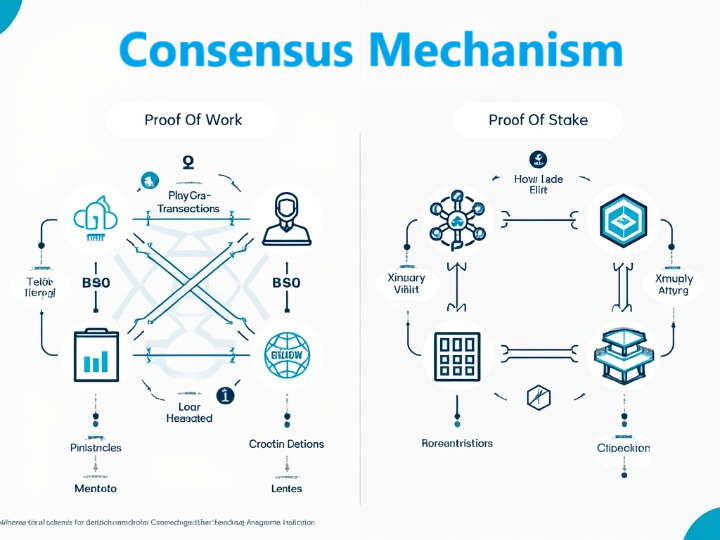Learn what a consensus mechanism is, how it works, and why it’s essential for blockchain security, including Proof of Work and other models.
Introduction
In the world of blockchain, Consensus Mechanism is a fundamental concept that ensures the security, transparency, and reliability of decentralized networks. Consensus Mechanisms allow different network participants to agree on the legitimacy of transactions and validate data without needing a central authority. This article dives deep into what a Consensus Mechanism is, how it works, and why it’s crucial for the functioning of blockchain technology.

What is a Consensus Mechanism?
A Consensus Mechanism is a protocol that allows multiple entities, often called nodes, within a distributed network to come to an agreement on the accuracy and validity of data. In the case of cryptocurrencies like Bitcoin, the Consensus Mechanism ensures that all transactions on the blockchain are validated by multiple nodes, preventing any possibility of tampering or double-spending.
The Consensus Mechanism plays a vital role in establishing trust among participants in a decentralized environment, where no single entity controls the network. For a blockchain to function securely, each participant needs assurance that the data recorded is legitimate.
How Does a Consensus Mechanism Work?
The process of reaching consensus in a blockchain relies on specific algorithms and protocols that require nodes to validate and agree on the information added to the blockchain. To reach consensus, nodes follow a set of rules predefined by the chosen Consensus Mechanism, which can vary depending on the type of blockchain.
There are various types of Consensus Mechanisms, each with its own unique approach to maintaining network security and achieving consensus. Let’s explore some popular ones:
Types of Consensus Mechanisms
Each blockchain network chooses its Consensus Mechanism based on its requirements for scalability, security, and energy efficiency. Here are some of the most widely used types:
1. Proof of Work (PoW)
Proof of Work (PoW) is perhaps the most well-known Consensus Mechanism, famously used by Bitcoin and Ethereum (until Ethereum moved to Proof of Stake in 2022). In PoW, miners compete to solve complex mathematical puzzles. The first to solve the puzzle can add a new block to the blockchain and earn a reward in the network’s cryptocurrency.
The competitive nature of PoW makes it secure, as it’s difficult for any single entity to gain control of the network. However, PoW has been criticized for its high energy consumption. So, Is Proof of Work a Consensus Mechanism? Yes, it is one of the earliest and most reliable forms of Consensus Mechanisms, ensuring data integrity and security across decentralized networks.
2. Proof of Stake (PoS)
Proof of Stake (PoS) is an energy-efficient alternative to PoW. Instead of relying on computational power, PoS requires validators to hold a stake (a certain amount of cryptocurrency) in the network. The probability of validating a new block is proportional to the number of coins a validator holds.
Since PoS doesn’t rely on power-hungry computations, it is seen as a more sustainable option. PoS is widely adopted by blockchains focused on energy efficiency, such as Ethereum’s new network, Cardano, and Polkadot.
3. Delegated Proof of Stake (DPoS)
Delegated Proof of Stake (DPoS) is a variant of PoS where network participants vote for a select group of validators, often referred to as “delegates.” These delegates are responsible for validating transactions and maintaining the network. By limiting the number of validators, DPoS achieves higher transaction speeds and scalability, making it ideal for blockchains aiming to support large-scale applications.
Why Consensus Protocols are Essential in Blockchain
Consensus Mechanisms serve as the backbone of blockchain technology by enabling trust in a trustless environment. Without a Consensus Mechanism, there would be no way to prevent malicious activity on the network, making blockchain vulnerable to fraud and manipulation. Here are the primary reasons why Consensus Mechanisms are indispensable:
1. Security and Trust
A Consensus Mechanism ensures that transactions added to the blockchain are legitimate. By requiring multiple nodes to validate transactions, it prevents double-spending and other fraudulent activities, creating a secure environment for users.
2. Decentralization
A major benefit of blockchains is their decentralized nature, and Consensus Mechanisms allow them to function without a central authority. By reaching consensus through a network of nodes, blockchain systems distribute control across the entire network.
3. Transparency
Because Consensus Mechanisms record all transactions on a public ledger, anyone can view the blockchain and verify transactions. This level of transparency builds trust in the system and allows participants to track the blockchain’s history.
4. Efficiency and Scalability
Consensus mechanisms like PoW are resource-intensive. Newer methods like PoS and DPoS aim to enhance scalability without compromising security.As blockchain continues to grow, scalability remains an essential factor for accommodating increasing transaction volumes.
Comparing Consensus Models: Proof of Work vs. Proof of Stake
As the two most popular Consensus Mechanisms, Proof of Work (PoW) and Proof of Stake (PoS) offer distinct approaches to achieving consensus. Here’s a comparison to understand their differences better:
| Feature | Proof of Work (PoW) | Proof of Stake (PoS) |
| Energy Efficiency | High energy consumption | Low energy consumption |
| Security | Highly secure due to computational power | Secure through financial staking |
| Validation | Based on mining power | Based on ownership of staked coins |
| Adoption | Used by Bitcoin, Litecoin | Used by Ethereum 2.0, Cardano, Polkadot |
| Scalability | Limited by resource demands | Improved scalability for larger transactions |
Each Consensus Mechanism has strengths and weaknesses, with PoW being highly secure but resource-intensive, and PoS offering a more sustainable, efficient alternative. Blockchain projects select their Consensus Mechanisms based on their goals and environmental priorities.
How Consensus Mechanisms Impact Blockchain Projects
Consensus Mechanisms play a crucial role in shaping the characteristics and performance of blockchain projects. Here are a few ways they impact a project’s success:
1. Transaction Speed and Cost
Faster Consensus Mechanisms can validate more transactions per second, reducing transaction costs. For example, DPoS-based blockchains can handle high transaction volumes at low fees, making them suitable for applications requiring quick settlements, like gaming and finance.
2. Network Security
While slower, Proof of Work networks provide robust security. This is particularly important for projects handling large-scale financial transactions, as they require the most reliable security measures.
3. Environmental Impact
As more industries focus on sustainability, Consensus Mechanisms like PoS are becoming favorable due to their reduced carbon footprint. Environmentally conscious projects are likely to adopt these energy-efficient mechanisms to align with their green goals.
Is Proof of Work the Right Consensus Mechanism for the Future?
Proof of Work has long been the gold standard for secure Consensus Mechanisms, but its high energy requirements have sparked debate. As environmental concerns grow, many blockchains are shifting towards Proof of Stake and other low-energy options.
Ultimately, there is no single Consensus Mechanism ideal for every blockchain project. Instead, developers choose a mechanism that best aligns with their network’s requirements, taking into account scalability, security, and environmental sustainability.
You might be interested in reading Understanding DApps for a Decentralized Future as well.
Final Thought
Understanding Consensus Mechanisms is essential for anyone interested in blockchain technology. Consensus Mechanisms enable secure, decentralized, and transparent networks, ensuring that all transactions recorded on the blockchain are legitimate and tamper-proof. From Proof of Work’s security to Proof of Stake’s efficiency, each mechanism offers unique benefits and trade-offs that impact a project’s scalability, sustainability, and security.
For those exploring blockchain, understanding consensus mechanisms is essential. They shape the very structure and functionality of the blockchain. Are you interested in learning more about how blockchains operate and what Consensus Mechanisms best fit different use cases? Leave a comment below and check back for our latest articles on blockchain technology.
What are your thoughts on Consensus Mechanisms in blockchain? Share your perspective in the comments below, and don’t forget to subscribe for more blockchain insights and updates.







